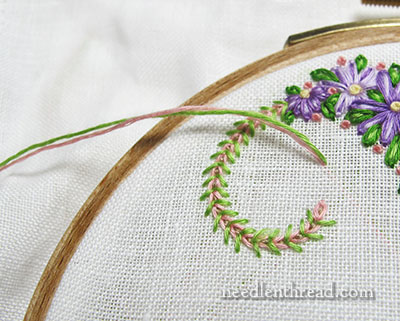Are you a thread parker? I am!
Parking your embroidery threads is a great way to save time and thread. If you’re not sure what “parking” means, I’ll show you!
Thread parking varies from project to project. On some projects, you might not need to park your threads. On other projects – especially projects that involve a lot of color packed into a small space (think needlepainting projects, very complex cross stitch projects, and the like) – you might have anywhere from two to a dozen or more threads parked at a time.

Here’s a shot of two parked embroidery threads on one of my letters from the Stitch Sampler Floral Alphabet I just finished.
Because I’m not finished just yet with the pink and green in that area of stitching, I’ve “parked” the threads by bringing them to the front of the fabric slightly away from the stitching area, to await the next time I need those two colors in that area. I didn’t end the threads, because I planned to use the same colors along that line to work some accent stitches.
Because I’m working on a relatively open weave piece of linen here, I can park my threads anywhere on the design area and they won’t leave a hole. But if you’re working on a tightly woven fabric, or any kind of silk or satin or solidly woven cotton where bringing your threads through the fabric like this might leave an open hole, you have to park your threads outside the design area.
The idea is to bring them to the front of the fabric in a spot that 1. won’t leave a hole within the design area; 2. won’t interfere with your other stitching; and 3. where you are aware that they are there (as opposed to parking them from the back of the work, where you can’t see the threads – this could result in a real mess on the back of the work!).

In the photo above, at this point, I’m working with three colors – a light purple, a dark purple, and a pale yellow. When the photo was taken, I was stitching with the dark purple, and I had already stitched in the yellow French knots and some light purple petals.
Because I knew I would use the light purple and the yellow again in that area, I didn’t want to end the threads. But I wanted to work in the dark purple petals and accents before I went back to the light purple and the light yellow.
So instead of ending the light purple and yellow threads, I brought them to the front of my work, away from the stitching area in a direction that wouldn’t interfere with my stitching.

Here, you can see them “parked” off to the side, away from the stitching area. To keep them out of the way, you can wrap them in a small loop and lay them against the fabric, or just leave them dangling, as long as you’re aware of them and you’re certain they won’t get caught up in your stitching.

Here, you can see the parked threads in relation to the work.
I use this time-saving technique in embroidery any time I’m using multiple colors of thread in a small area. There’s no point in ending the threads if I’m going to use them again, so I just park them until I need them again. As long as I know I won’t need to carry the thread a long distance across the back or across an open space of fabric (in a way that the thread would show through), I can go back to the thread and use it again without finishing off and re-starting it.
Using a Needle Minder
Some embroiderers use needle minders or magnets to help them park threads. If you leave each thread threaded in a needle, you can park your thread by bringing it to the front (again, out of the design area if you fear a noticeable hole would be left in the fabric) and rest the needle on a magnetized needle minder (or even just poke the needle into the fabric, as long as you’re certain the needle won’t get in the way of your hand).
This saves even more time, because you don’t have to re-thread your needle each time you change threads, but it requires multiple needles. If you’re working with a dozen colors, this can be a little problematic.
Avoid Chaos with Threads!
I find it easier, though, to park needles and threads as spread out as possible around the outside edge of my work area.
If the threads are all bunched up around one needle minder, it’s easier for chaos to ensue, so parking my threads farther apart (sort of fanning them out along the edge of the work) works better for me. But, again, it all depends on the number of threads you’re using and on your own personal stitching techniques and preferences.
So, what about you? Are you a thread parker? If so, how do you go about parking them? Do you use a needle minder, or do you just bring them to the front of the fabric out of the way? Do you leave the needle on, or take it off? Any tips to share? Have your say below!
